Yamaha PSR-S750, PSR-S950 User Manual
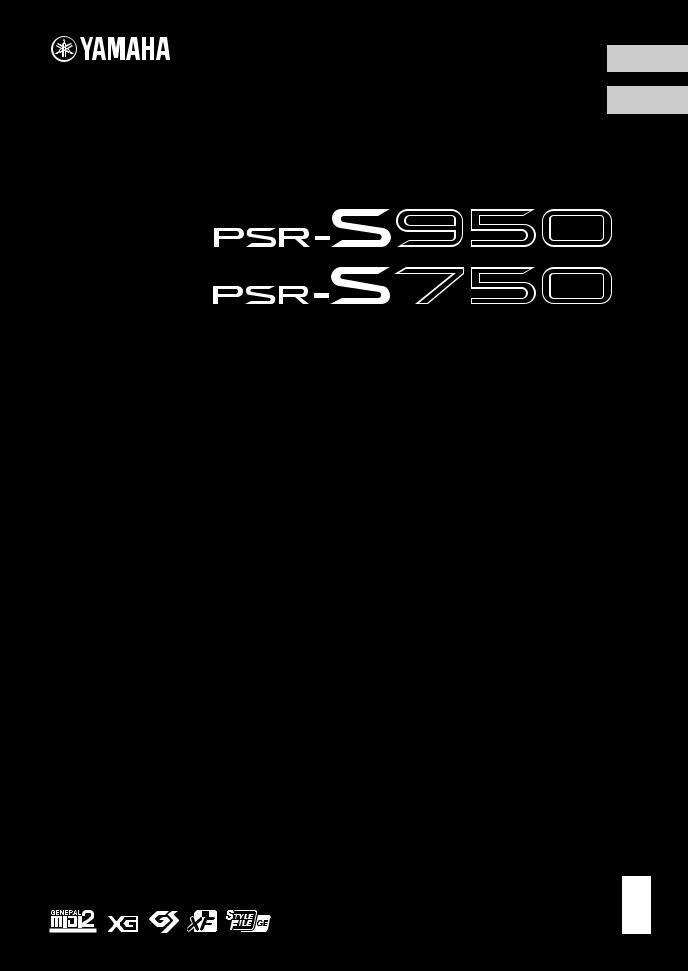
English
Français
Digital Workstation
Clavier Arrangeur Professionnel
Owner’s Manual
Mode d'emploi
Français English
Thank you for purchasing this Yamaha Digital Workstation!
We recommend that you read this manual carefully so that you can fully take advantage of the advanced and convenient functions of the instrument.
We also recommend that you keep this manual in a safe and handy place for future reference. Before using the instrument, be sure to read “PRECAUTIONS” on pages 4 – 5.
Merci d'avoir choisi ce Clavier Arrangeur Professionnel Yamaha !
Nous vous conseillons de lire attentivement ce mode d'emploi afin de tirer pleinement profit des fonctions avancées et très utiles de votre instrument.
Nous vous recommandons également de garder ce manuel à portée de main pour toute référence ultérieure. Avant d'utiliser l'instrument, lisez attentivement la section « PRÉCAUTIONS D'USAGE » aux pages 4 et 5.
EN
FR
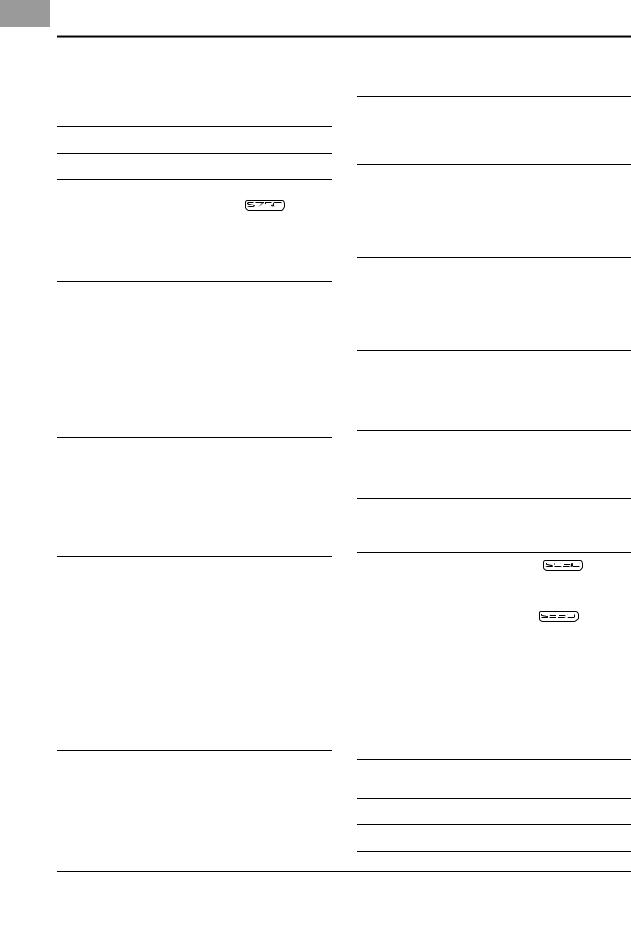
Table of Contents
|
Included Accessories ...................................................... |
6 |
|
Formats ............................................................................ |
6 |
|
About the Manuals ........................................................... |
7 |
Welcome to Digital Workstation |
8 |
|
Panel Controls and Terminals |
10 |
|
Starting Up |
14 |
|
|
Turning the Power On and Playing the Keyboard.......... |
14 |
|
Adjusting the Contrast of the Display |
|
|
(PSR-S750 only) ............................................................. |
16 |
|
Changing the Display Language ................................... |
16 |
|
Displaying the Version Number ..................................... |
17 |
|
Playing the Demos ......................................................... |
17 |
Basic Operations |
18 |
|
|
Display-based Controls.................................................. |
18 |
|
Messages Shown in the Display .................................... |
21 |
|
Instant Selection of the Displays — Direct Access........ |
21 |
|
Main Display Configuration............................................ |
22 |
|
File Selection Display Configuration .............................. |
24 |
|
File Management ........................................................... |
26 |
|
Entering Characters ....................................................... |
30 |
|
Resetting to the Factory-programmed Settings............. |
31 |
|
Data Backup .................................................................. |
31 |
1 |
Voices |
|
|
– Playing the keyboard – |
32 |
|
Playing Preset Voices .................................................... |
32 |
|
Expanding Voices .......................................................... |
36 |
|
Transposing the Pitch of the Keyboard.......................... |
38 |
|
Using the Wheels ........................................................... |
39 |
|
Applying Voice Effects................................................... |
39 |
|
Creating Your Original Organ Flutes Voices.................. |
41 |
2 |
Styles |
|
|
– Playing Rhythm and Accompaniment – |
43 |
|
Playing a Style with the Auto Accompaniment............... |
43 |
|
Chords ........................................................................... |
45 |
|
Operating Style Playback............................................... |
46 |
|
Calling up Appropriate Panel Settings for the |
|
|
Current Style (Repertoire) .............................................. |
48 |
|
Calling up Appropriate Panel Settings for the |
|
|
Current Style (One Touch Setting) ................................. |
49 |
|
Calling up Optimum Styles for Your Performance |
|
|
(Style Recommender) .................................................... |
50 |
|
Turning Style Parts On/Off and Changing Voices.......... |
52 |
|
Adjusting the Volume Balance Between the Style |
|
|
and Keyboard ................................................................ |
53 |
3 |
Songs |
|
|
– Playing, Practicing and Recording Songs – |
54 |
|
Playback of Songs ......................................................... |
54 |
|
Displaying Music Notation (Score)................................. |
56 |
|
Displaying Lyrics (Text).................................................. |
57 |
|
Turning Song Channels On/Off...................................... |
57 |
|
Practicing the Right-hand Part with Guide Functions .... |
58 |
|
Repeat Playback............................................................ |
59 |
|
Recording Your Performance......................................... |
60 |
4 USB Audio |
|
– Playback and Recording Audio Files – |
64 |
Playing Back Audio Files ............................................... |
64 |
Recording Your Performance as Audio ......................... |
67 |
5Multi Pads
– Adding Musical Phrases to Your Performance – 69
Playing the Multi Pads.................................................... |
69 |
Using the Multi Pad Synchro Start Function .................. |
70 |
Using Chord Match........................................................ |
70 |
Using WAVE Files for the Multi Pads ............................. |
71 |
6Music Finder
– Calling Up Ideal Panel Setups for Your Performance – 73
Selecting a Record (Your Desired Music Genre) .......... |
75 |
Finding Your Desired Record (Panel Settings) via |
|
Search............................................................................ |
76 |
Registering a Song, Audio or Style File ......................... |
77 |
7Registration Memory
– Saving and Recalling Custom Panel Setups – 79
Registering Your Panel Setups ...................................... |
79 |
Saving the Registration Memory as a Bank file ............. |
80 |
Recalling a Registered Panel Setup .............................. |
81 |
8Microphone
– Adding Vocal Harmony Effects to Your Singing –  82
82
Connecting a Microphone ............................................. |
82 |
Applying the Vocal Harmony Effects to Your Voice....... |
83 |
9Mixing Console
|
– Editing the Volume and Tonal Balance – |
86 |
|
Basic Procedure ............................................................ |
86 |
10 |
Connections |
|
|
– Using Your Instrument with Other Devices – |
88 |
|
Connecting a Microphone or Guitar |
|
|
([MIC/LINE IN] jack)....................................................... |
88 |
|
Connecting Audio Devices |
|
|
(OUTPUT [L/L+R]/[R] jacks, [AUX IN] jack) .................. |
89 |
|
Connecting a Separate TV Monitor |
|
|
([VIDEO OUT] jack)........................................................ |
90 |
|
Connecting a Footswitch/Foot Controller |
|
|
([FOOT PEDAL] jacks)................................................... |
91 |
|
Connecting a USB Flash Memory |
|
|
([USB TO DEVICE] terminal).......................................... |
92 |
|
Connecting to a Computer ([USB TO HOST] terminal) .93 |
|
|
Connecting External MIDI Devices |
|
|
(MIDI [IN]/[OUT] terminals)............................................ |
94 |
11 |
Utility |
|
|
– Making Global Settings – |
95 |
|
Basic Procedure ............................................................ |
95 |
Troubleshooting |
96 |
|
Specifications |
99 |
|
Index |
101 |
|
2PSR-S950/S750 Owner’s Manual
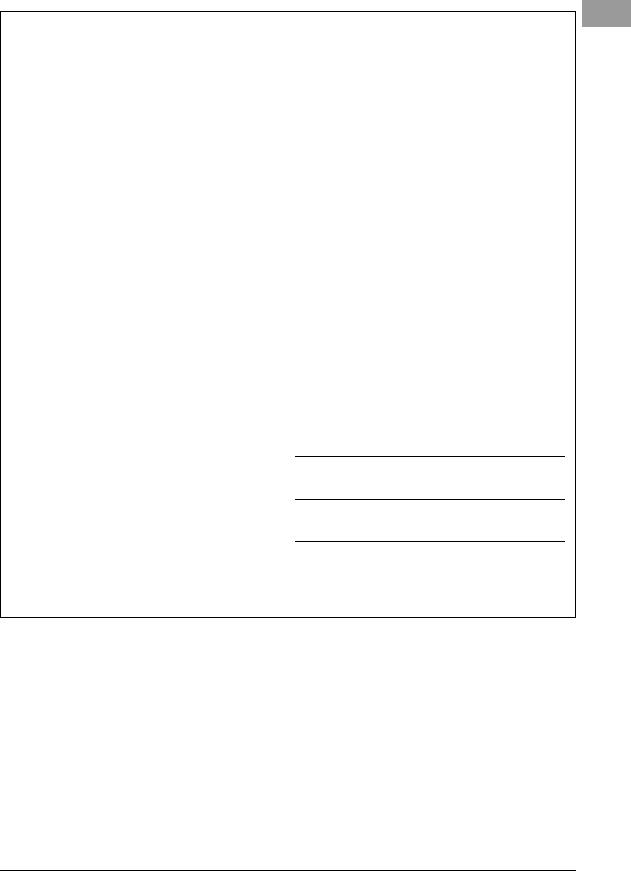
SPECIAL MESSAGE SECTION
This product utilizes batteries or an external power supply (adapter). DO NOT connect this product to any power supply or adapter other than one described in the manual, on the name plate, or specifically recommended by Yamaha.
WARNING: Do not place this product in a position where anyone could walk on, trip over, or roll anything over power or connecting cords of any kind. The use of an extension cord is not recommended! If you must use an extension cord, the minimum wire size for a 25’ cord (or less ) is 18 AWG. NOTE: The smaller the AWG number, the larger the current handling capacity. For longer extension cords, consult a local electrician.
This product should be used only with the components supplied or; a cart, rack, or stand that is recommended by Yamaha. If a cart, etc., is used, please observe all safety markings and instructions that accompany the accessory product.
SPECIFICATIONS SUBJECT TO CHANGE:
The information contained in this manual is believed to be correct at the time of printing. However, Yamaha reserves the right to change or modify any of the specifications without notice or obligation to update existing units.
This product, either alone or in combination with an amplifier and headphones or speaker/s, may be capable of producing sound levels that could cause permanent hearing loss. DO NOT operate for long periods of time at a high volume level or at a level that is uncomfortable. If you experience any hearing loss or ringing in the ears, you should consult an audiologist.
IMPORTANT: The louder the sound, the shorter the time period before damage occurs.
Some Yamaha products may have benches and / or accessory mounting fixtures that are either supplied with the product or as optional accessories. Some of these items are designed to be dealer assembled or installed. Please make sure that benches are stable and any optional fixtures (where applicable) are well secured BEFORE using.
Benches supplied by Yamaha are designed for seating only. No other uses are recommended.
NOTICE:
Service charges incurred due to a lack of knowledge relating to how a function or effect works (when the unit is operating as designed) are not covered by the manufacturer’s warranty, and are therefore the owners responsibility. Please study this manual carefully and consult your dealer before requesting service.
ENVIRONMENTAL ISSUES:
Yamaha strives to produce products that are both user safe and environmentally friendly. We sincerely believe that our products and the production methods used to produce them, meet these goals. In keeping with both the letter and the spirit of the law, we want you to be aware of the following:
Battery Notice:
This product MAY contain a small non-rechargeable battery which (if applicable) is soldered in place. The average life span of this type of battery is approximately five years. When replacement becomes necessary, contact a qualified service representative to perform the replacement.
This product may also use “household” type batteries. Some of these may be rechargeable. Make sure that the battery being charged is a rechargeable type and that the charger is intended for the battery being charged.
When installing batteries, never mix old batteries with new ones, and never mix different types of batteries. Batteries MUST be installed correctly. Mismatches or incorrect installation may result in overheating and battery case rupture.
Warning:
Do not attempt to disassemble, or incinerate any battery. Keep all batteries away from children. Dispose of used batteries promptly and as regulated by the laws in your area. Note: Check with any retailer of household type batteries in your area for battery disposal information.
Disposal Notice:
Should this product become damaged beyond repair, or for some reason its useful life is considered to be at an end, please observe all local, state, and federal regulations that relate to the disposal of products that contain lead, batteries, plastics, etc. If your dealer is unable to assist you, please contact Yamaha directly.
NAME PLATE LOCATION:
The name plate is located on the bottom of the product. The model number, serial number, power requirements, etc., are located on this plate. You should record the model number, serial number, and the date of purchase in the spaces provided below and retain this manual as a permanent record of your purchase.
Model
Serial No.
Purchase Date
PLEASE KEEP THIS MANUAL
92-BP (bottom)
PSR-S950/S750 Owner’s Manual |
3 |
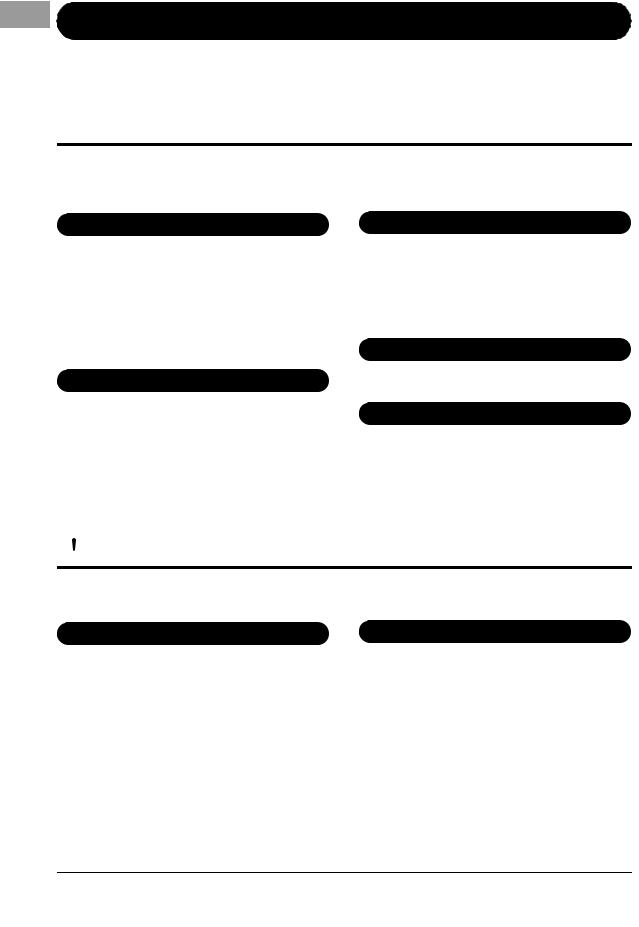
PRECAUTIONS
PLEASE READ CAREFULLY BEFORE PROCEEDING
Please keep this manual in a safe and handy place for future reference.
 WARNING
WARNING
Always follow the basic precautions listed below to avoid the possibility of serious injury or even death from electrical shock, short-circuiting, damages, fire or other hazards. These precautions include, but are not limited to, the following:
|
|
Water warning |
Power supply/AC power adaptor |
||
|
|
|
•Do not place the power cord near heat sources such as heaters or radiators. Also, do not excessively bend or otherwise damage the cord, or place heavy objects on it.
•Only use the voltage specified as correct for the instrument. The required voltage is printed on the name plate of the instrument.
•Use the specified adaptor (page 100) only. Using the wrong adaptor can result in damage to the instrument or overheating.
•Check the electric plug periodically and remove any dirt or dust which may have accumulated on it.
Do not open
•This instrument contains no user-serviceable parts. Do not open the instrument or attempt to disassemble or modify the internal components in any way. If it should appear to be malfunctioning, discontinue use immediately and have it inspected by qualified Yamaha service personnel.
 CAUTION
CAUTION
•Do not expose the instrument to rain, use it near water or in damp or wet conditions, place on it any containers (such as vases, bottles or glasses) containing liquids which might spill into any openings. If any liquid such as water seeps into the instrument, turn off the power immediately and unplug the power cord from the AC outlet. Then have the instrument inspected by qualified Yamaha service personnel.
•Never insert or remove an electric plug with wet hands.
Fire warning
•Do not put burning items, such as candles, on the unit. A burning item may fall over and cause a fire.
If you notice any abnormality
•When one of the following problems occur, immediately turn off the power switch and disconnect the electric plug from the outlet. Then have the device inspected by Yamaha service personnel.
-The power cord or plug becomes frayed or damaged.
-It emits unusual smells or smoke.
-Some object has been dropped into the instrument.
-There is a sudden loss of sound during use of the instrument.
Always follow the basic precautions listed below to avoid the possibility of physical injury to you or others, or damage to the instrument or other property. These precautions include, but are not limited to, the following:
|
|
|
|
|
Location |
Power supply/AC power adaptor |
||
|
|
|
•Do not connect the instrument to an electrical outlet using a multiple-connector. Doing so can result in lower sound quality, or possibly cause overheating in the outlet.
•When removing the electric plug from the instrument or an outlet, always hold the plug itself and not the cord. Pulling by the cord can damage it.
•Remove the electric plug from the outlet when the instrument is not to be used for extended periods of time, or during electrical storms.
•Do not place the instrument in an unstable position where it might accidentally fall over.
•Do not place objects in front of the instrument’s air vent, since this may prevent adequate ventilation of the internal components, and possibly result in the instrument overheating.
•Before moving the instrument, remove all connected cables, to prevent damage to the cables or injury to anyone who might trip over them.
•When setting up the product, make sure that the AC outlet you are using is easily accessible. If some trouble or malfunction occurs, immediately turn off the power switch and disconnect the plug from the outlet. Even when the power switch is turned off, electricity is still flowing to the product at the minimum level. When you are not using the product for a long time, make sure to unplug the power cord from the wall AC outlet.
•Use only the stand specified for the instrument. When attaching the stand or rack, use the provided screws only. Failure to do so could cause damage to the internal components or result in the instrument falling over.
DMI-5 1/2
4PSR-S950/S750 Owner’s Manual
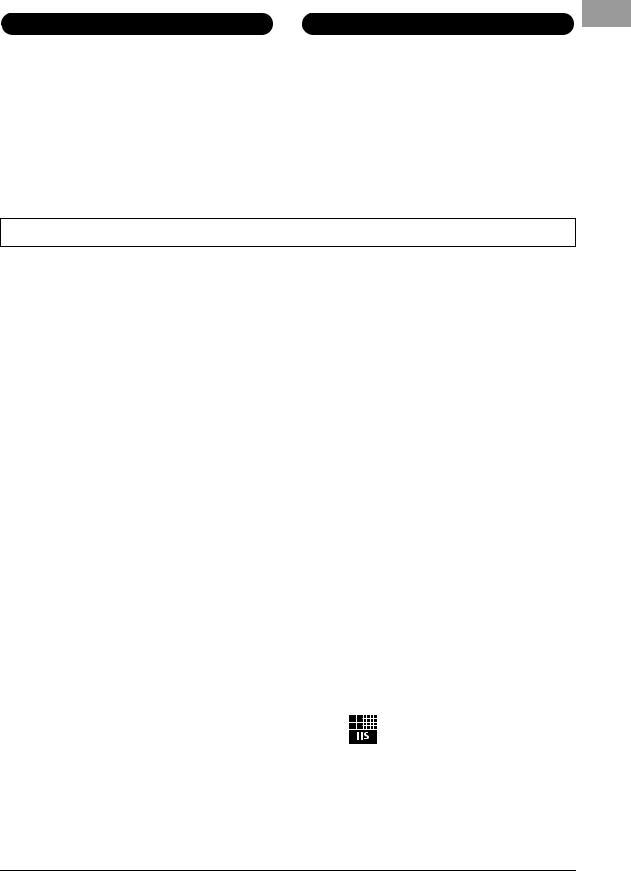
Connections
•Before connecting the instrument to other electronic components, turn off the power for all components. Before turning the power on or off for all components, set all volume levels to minimum.
•Be sure to set the volumes of all components at their minimum levels and gradually raise the volume controls while playing the instrument to set the desired listening level.
Handling caution
•Do not insert a finger or hand in any gaps on the instrument.
•Never insert or drop paper, metallic, or other objects into the gaps on the panel. This could cause physical injury to you or others, damage to the instrument or other property, or operational failure.
•Do not rest your weight on, or place heavy objects on the instrument, and do not use excessive force on the buttons, switches or connectors.
•Do not use the instrument/device or headphones for a long period of time at a high or uncomfortable volume level, since this can cause permanent hearing loss. If you experience any hearing loss or ringing in the ears, consult a physician.
Yamaha cannot be held responsible for damage caused by improper use or modifications to the instrument, or data that is lost or destroyed.
Always turn the power off when the instrument is not in use.
Even when the [  ] (Standby/On) switch is in standby status (display is off), electricity is still flowing to the instrument at the minimum level. When you are not using the instrument for a long time, make sure you unplug the power cord from the wall AC outlet.
] (Standby/On) switch is in standby status (display is off), electricity is still flowing to the instrument at the minimum level. When you are not using the instrument for a long time, make sure you unplug the power cord from the wall AC outlet.
NOTICE
To avoid the possibility of malfunction/ damage to the product, damage to data, or damage to other property, follow the notices below.
Handling and Maintenance
•Do not use the instrument in the vicinity of a TV, radio, stereo equipment, mobile phone, or other electric devices. Otherwise, the instrument, TV, or radio may generate noise.
•Do not expose the instrument to excessive dust or vibrations, or extreme cold or heat (such as in direct sunlight, near a heater, or in a car during the day) to prevent the possibility of panel disfiguration, damage to the internal components or unstable operation. (Verified operating temperature range: 5° – 40°C, or 41° – 104°F.)
•Do not place vinyl, plastic or rubber objects on the instrument, since this might discolor the panel or keyboard.
•When cleaning the instrument, use a soft cloth. Do not use paint thinners, solvents, cleaning fluids, or chemical-impregnated wiping cloths.
Saving data
•The edited Songs/Styles/Voices/Multi Pads and MIDI settings are lost when you turn off the power of the instrument without saving. Save the edited data to the instrument (USER tab display) or a USB flash memory (USB tab display); see page 24. Moreover, it is safer to save the data to a USB flash memory, because the data in the USER tab display may be lost due to malfunction or incorrect operation. To protect against data loss through USB flash memory damage, we recommend that you save your important data onto two USB flash memories.
•Data other than above (edited Songs/Styles/Voices/Multi Pads and MIDI settings) is automatically stored, when you change the settings in a display page and then exit from that page. However, the data is lost if you turn off the power without properly exiting from the relevant display.
Information
About copyrights
• Copying of the commercially available musical data including but not limited to MIDI data and/or audio data is strictly prohibited except for your personal use.
• This product incorporates and bundles computer programs and contents in which Yamaha owns copyrights or with respect to which it has license to use others’ copyrights. Such copyrighted materials include, without limitation, all computer software, style files, MIDI files, WAVE data, musical scores and sound recordings. Any unauthorized use of such programs and contents outside of personal use is not permitted under relevant laws. Any violation of copyright has legal consequences. DON’T MAKE, DISTRIBUTE OR USE ILLEGAL COPIES.
About functions/data bundled with the instrument
•Some of the preset songs have been edited for length or arrangement, and may not be exactly the same as the original.
•This device is capable of using various types/formats of music data by optimizing them to the proper format music data for use with the device in advance. As a result, this device may not play them back precisely as their producers or composers originally intended.
•The bitmap fonts used in this instrument have been provided by and are the property of Ricoh Co., Ltd.
• (PSR-S950) MPEG Layer-3 audio coding technology licensed from Fraunhofer IIS and Thomson.
DMI-5 2/2
PSR-S950/S750 Owner’s Manual |
5 |

Included Accessories
•Owner’s Manual
•Online Member Product Registration
You will need the PRODUCT ID on the sheet in order to fill out the User Registration form.
•Music Rest
•AC Power Adaptor
This may not be included depending on your particular area. Please check with your Yamaha dealer.
Formats
The instrument is compatible with the following formats.
“GM (General MIDI)” is one of the most common Voice allocation formats. “GM System Level 2” is a standard specification that enhances the original “GM” and improves Song data compatibility. It provides for increased polyphony, greater Voice selection, expanded Voice parameters, and integrated effect processing.
XG is a major enhancement of the GM System Level 1 format, and was developed by Yamaha specifically to provide more Voices and variations, as well as greater expressive control over Voices and effects, and to ensure compatibility of data well into the future.
GS was developed by the Roland Corporation. In the same way as Yamaha XG, GS is a major enhancement of the GM specifically to provide more Voices and Drum kits and their variations, as well as greater expressive control over Voices and effects.
The Yamaha XF format enhances the SMF (Standard MIDI File) standard with greater functionality and open-ended expandability for the future. This instrument is capable of displaying lyrics when an XF file containing lyric data is played.
“SFF (Style File Format)” is an original Style file format by Yamaha which uses a unique conversion system to provide highquality automatic accompaniment based on a wide range of chord types. “SFF GE (Guitar Edition)” is an enhanced format of SFF, which features improved note transposition for guitar tracks.
The followings are the titles, credits and copyright notices for the songs pre-installed in this instrument:
(PSR-S950, PSR-S750)
Beauty And The Beast
from Walt Disney’s BEAUTY AND THE BEAST Lyrics by Howard Ashman
Music by Alan Menken
©1991 Walt Disney Music Company and Wonderland Music Company, Inc. All Rights Reserved Used by Permission
(PSR-S950)
Achy Breaky Heart (Don’t Tell My Heart) Words and Music by Don Von Tress
Copyright ©1991 UNIVERSAL - MILLHOUSE MUSIC All Rights Reserved Used by Permission
(PSR-S750)
Can’t Help Falling In Love
from the Paramount Picture BLUE HAWAII
Words and Music by George David Weiss, Hugo Peretti and Luigi Creatore Copyright ©1961; Renewed 1989 Gladys Music (ASCAP)
Worldwide Rights for Gladys Music Administered by Cherry Lane Music Publishing Company, Inc. International Copyright Secured All Rights Reserved
6PSR-S950/S750 Owner’s Manual
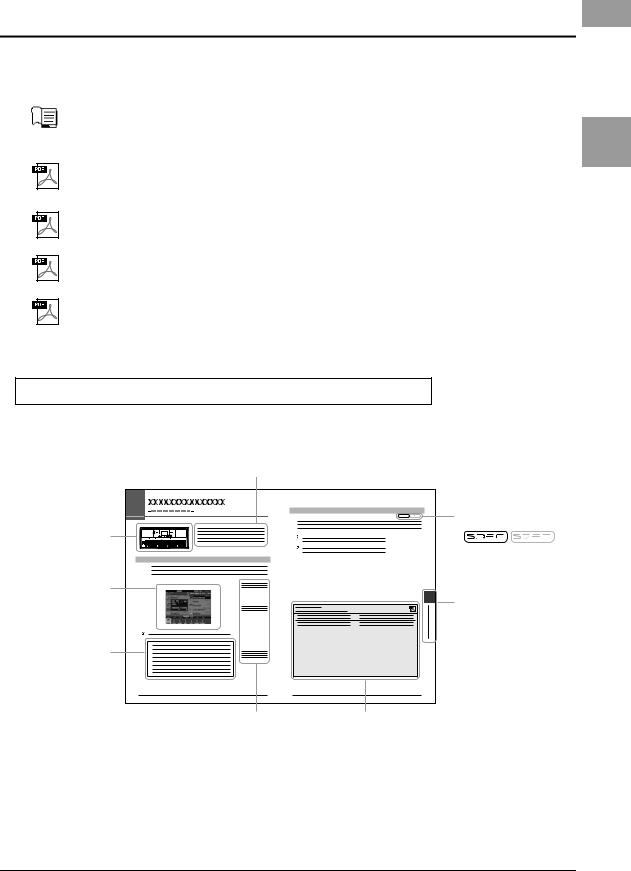
About the Manuals
This instrument has the following document and instructional materials.
Included Document
Owner’s Manual (this book)
Provides overall explanations of the PSR-S950/S750 basic functions. See “How to use this Owner’s Manual” below.
Online Materials (PDF)
Reference Manual (only in English, French, German and Spanish)
Explains advanced features of the instrument, not explained in the Owner’s Manual. For example, you can learn how to create original Styles, Songs or Multi Pads, or find detailed explanations of specific parameters.
Data List
Contains various important preset content lists such as Voices, Styles, Effects, as well as MIDI-related information.
Computer-related Operations
Includes instructions on connecting this instrument to a computer, and operations related to transferring song data.
MIDI Basics (only in English, French, German and Spanish)
If you want to know more about MIDI and how to use it, refer to this introductory book.
To obtain these materials, access the Yamaha Manual Library, enter “PSR-S950,” “PSR-S750” or “MIDI Basics” to the Model Name box, then click [SEARCH].
Yamaha Manual Library http://www.yamaha.co.jp/manual/
About the Manuals
How to use this Owner’s Manual
Provides an overview of the chapter contents.
Shows the location of buttons which are explained in the chapter.
The displays are taken from the PSR-S950, and in English. (These may appear somewhat different from those on your instrument.)
Boxed sections provide additional helpful information.
Shows that this function is only available on one model.
Ex.: These icons indicate that this function is only on the PSR-S950 but not on the PSR-S750.
Chapter title for navigating through the manual.
Provides supplemen- |
Introduces advanced features related |
tary notes and detailed |
to the chapter contents. |
information. |
Detailed explanations are provided in |
|
the Reference Manual (above). |
•The illustrations and LCD screens as shown in this manual are for instructional purposes only, and may appear somewhat different from those on your instrument.
•The company names and product names in this manual are the trademarks or registered trademarks of their respective companies.
PSR-S950/S750 Owner’s Manual |
7 |

 Welcome to Digital Workstation
Welcome to Digital Workstation
Explore the Demos Starting Up
The Demos showcase the variety of stunning Voices and Styles on the instrument, and give you hands-on experience using it.
Play a Wide Variety of Instrument Voices Chapter 1 Voices
The instrument gives you not only various realistic piano Voices, but also features an exceptionally wide variety of authentic instruments, both acoustic and electronic.
Perform Along with a Backing Band Chapter 2 Styles
Playing a chord with your left hand automatically plays the auto accompaniment backing (Style function). Select an accompaniment style — such as pop, jazz, Latin, and various other music genres in the world — and let the instrument be your backing band!
Play Along with Song Data Chapter 3 Songs
Playing Back Songs ................page 54
Play along with a Song data, and fill out your solo performance with the sounds of an entire band or orchestra. Enjoy a wide variety of songs — commercially available music data and preset songs.
Displaying Music Score |
................page 56 |
While playing back a Song, you can have the music score (notation) automatically shown on the display — an exceptionally convenient tool for learning and practicing pieces.
Recording Your Performance ................ |
page 60 |
The instrument lets you easily record your own performance and save it to internal memory or a USB flash memory. The instrument also lets you listen back to your performance, and further edit it or utilize it for your music production.
8PSR-S950/S750 Owner’s Manual
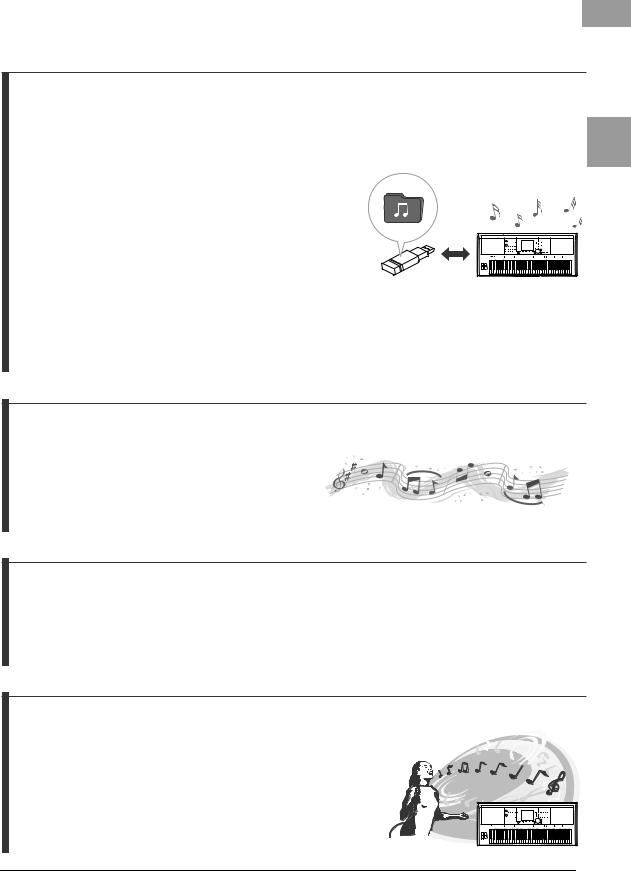
Audio Playing and Recording from USB Flash Memory Chapter 4 USB Audio
Audio files (WAVE or MP3*) saved to USB flash memory can be played back on the instrument. Moreover, you can record your performance as audio file (WAVE) to a USB flash memory device. On the PSR-S950, you can connect a microphone to the instrument and enjoy recording your singing along with the keyboard performance.
* The MP3 format is supported only by the PSR-S950.
On the PSR-S950 only, there are also a variety of advanced, convenient audio playback and processing functions. These include Repeat Mode, for specifying how audio files will be repeatedly played back, and an A-B Repeat function, for repeating a specific section in a audio song. Time Stretch lets you slow down or speed up an audio file without changing the pitch, while Pitch Shift lets you change the pitch of the audio without affecting the time. Moreover, a Vocal Cancel function effectively attenuates the vocals which may be positioned in the center of a file, allowing you to sing “karaoke” style with just instrumental backing.
Add Phrases and Rhythms to Your Performance Chapter 5 Multi Pads
You can add spice to your performance with special short phrases and rhythms, simply by tapping the Multi Pads. Multi Pads also have an Audio Link function that allows you to create your own audio data (sound effects, vocal phrases, and so on), and trigger them from the Pads as you perform.
Call Up the Ideal Voice and Style for Each Song Chapter 6 Music Finder
The convenient Music Finder function lets you call up the ideal panel settings including the most suitable Voice, Style, effects, etc. for each song, by selecting a “Record,” music genre or song title. Moreover, by registering Songs, audio and Style files saved in various places into Music Finder, the instrument can call up these Songs, audio and Style files easily from the song title.
Add Vocal Harmony Effects to Your Singing (PSR-S950) Chapter 8 Microphone
The instrument also lets you directly connect a microphone and use a variety of sophisticated processing tools specifically designed for vocals. These include an amazing Vocal Harmony function, which automatically produces backup vocal harmonies for lead vocals that you sing into a microphone. You can even change the gender of the harmony voices — for example, letting you add female backup to your own male voice (or vice versa) — or use the Vocal Doubler to make your single voice sound like many.
Welcome to Digital Workstation
PSR-S950/S750 Owner’s Manual |
9 |

Panel Controls and Terminals
Top Panel |
|
|
|
|
|
|
|
|
% |
|
|
|
|
(PSR-S750) |
|
|
|
1 |
|
|
|
|
5 |
|
|
|
|
2 |
^ |
|
|
|
6 |
& |
|
|
|
3 |
|
|
|
|
* |
|
|
|
|
|
|
|
|
|
4 |
( |
|
|
|
7 |
|
|
|
|
|
|
|
|
|
8 |
9 |
|
|
) |
! |
|
|
@ |
# |
|
|
|
|
$ |
|
|
1 [ |
] (Standby/On) switch ..............................Page 14 |
9 [METRONOME] button |
|
|
Turns on the instrument’s power or sets to standby. |
|
Turns the metronome on or off. |
|
|
2 [MASTER VOLUME] dial ................................ |
Page 14 |
) [FADE IN/OUT] button.................................... |
Page 47 |
|
Adjusts the overall volume. |
|
Controls fade in/out of Style/Song playback. |
|
|
3 [DEMO] button ................................................ |
Page 17 |
! STYLE CONTROL buttons............................. |
Page 46 |
|
Calls up the display for selecting a Demo. |
|
Controls Style playback. |
|
|
4 [MIC SETTING/VOCAL HARMONY] button |
|
@ [PITCH BEND] wheel...................................... |
Page 39 |
|
(PSR-S950)...................................................... |
Page 83 |
Bends the pitch of the keyboard played sound up or down. |
||
Calls up the display for adding various effects to the Micro- |
# [MODULATION] wheel ................................... |
Page 39 |
||
phone input. |
|
Applies a vibrato effect. |
|
|
5 SONG buttons................................................. |
Page 54 |
$ [PHONES] jack ............................................... |
Page 13 |
|
Selects a Song and controls Song playback. |
|
For connecting a pair of headphones. |
|
|
6 STYLE category selection buttons ............... |
Page 43 |
% [LCD CONTRAST] knob (PSR-S750) ............ |
Page 16 |
|
Selects a Style category. |
|
Adjusts the LCD contrast. |
|
|
7 [TAP TEMPO]/TEMPO buttons ...................... |
Page 47 |
^ LCD and related controls .............................. |
Page 18 |
|
Controls the tempo for Style, Song and Metronome playback. |
& [BALANCE] button |
Page 53 |
||
8 TRANSPOSE buttons |
Page 38 |
|||
Calls up settings for the volume balance among the parts. |
||||
Transposes the entire pitch of the instrument in semitone |
||||
|
|
|||
steps. |
|
|
|
|
10 PSR-S950/S750 Owner’s Manual
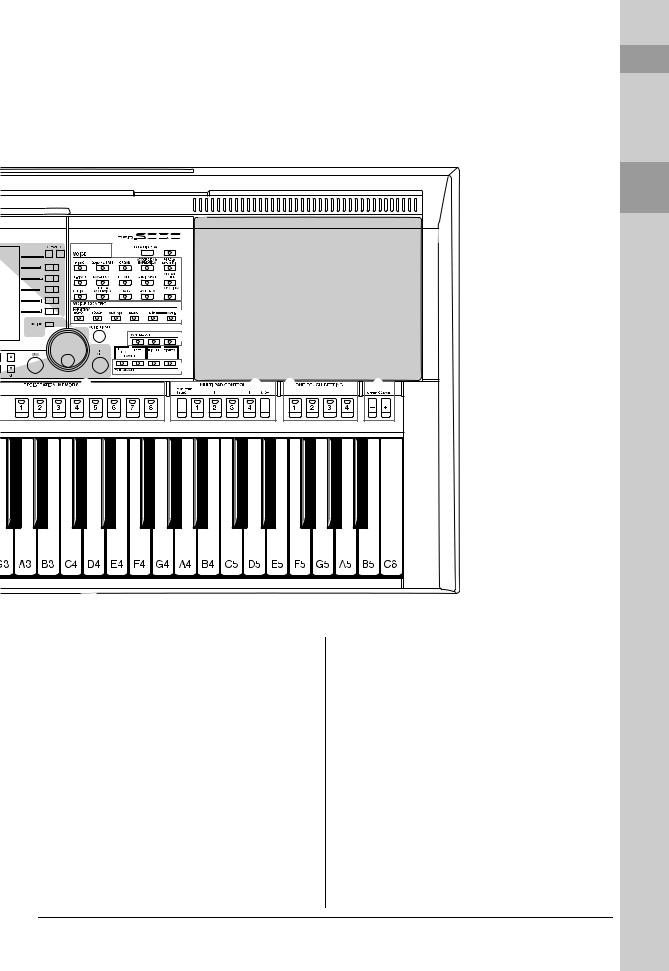
B |
C |
D |
|
Terminalsand |
|
|
E |
|
Controls |
|
|
|
|
|
A |
F |
G |
|
|
|
|
Panel |
||
|
|
H |
|
|
I |
|
J |
K |
L |
* [MIXING CONSOLE] button |
...........................Page |
86 |
Calls up various settings for the keyboard, Style and Song |
||
parts. |
|
|
( [CHANNEL ON/OFF] button................... |
Pages 52, |
57 |
Calls up settings for turning Style/Song channels on or off.
A[FUNCTION] button
(See Reference Manual on website.)
Lets you make advanced settings and create your original Styles, Songs and Multi Pads.
B VOICE category selection buttons................ |
Page 32 |
Selects a Voice. |
|
C [USB AUDIO PLAYER] button........................ |
page 64 |
Calls up the display for playing back audio files and record- |
|
ing your performance in audio format. |
|
D [USB] button ................................................... |
page 24 |
Calls up the display for selecting a file in the USB flash memory.
E VOICE CONTROL buttons ............................. |
Page 39 |
Applies various effects to the keyboard performance.
F [MUSIC FINDER] button................................. |
page 75 |
Calls up ideal panel setups for your performance.
G PART SELECT buttons .................................. |
Page 35 |
Selects a keyboard part. |
|
H PART ON/OFF buttons ................................... |
Page 35 |
Turns the keyboard part on or off. |
|
I REGISTRATION MEMORY buttons ............... |
Page 79 |
Registers and recalls panel setups. |
|
J MULTI PAD CONTROL buttons ..................... |
Page 69 |
Selects and plays a rhythmic or melodic Multi Pad phrase.
K ONE TOUCH SETTING buttons..................... |
Page 49 |
Calls up the appropriate panel settings for the Style.
L UPPER OCTAVE buttons ............................... |
Page 38 |
Shifts the pitch of the keyboard in octave steps.
PSR-S950/S750 Owner’s Manual |
11 |

 Rear Panel
Rear Panel
1 2 3 4 5 6 7
1 DC IN jack ....................................................... |
Page 14 |
For connecting the power adaptor. |
|
2 [FOOT PEDAL] jacks ...................................... |
Page 91 |
For connecting Footswitches and/or Foot controllers. |
|
3 OUTPUT [L/L+R]/[R] jacks ............................. |
Page 89 |
For connecting external audio devices. |
|
4 |
[AUX IN] jack................................................... |
Page 89 |
|
For connecting an external audio device, such as a portable |
|
|
audio player. |
|
5 |
[MIC/LINE IN] jack (PSR-S950)...................... |
Page 88 |
|
For connecting a microphone or guitar. |
|
6 |
[INPUT VOLUME] knob (PSR-S950).............. |
page 83 |
For adjusting the input level of the [MIC/LINE IN] jack.
Air Vents
Air Vents
NOTICE
This instrument has special air vents in the top panel and rear panel. Do not place objects where they might block the air vent, since this may prevent adequate ventilation of the internal components, and possibly result in the instrument overheating.
Attaching the Music Rest
The instrument is supplied with a music rest that can be attached to the instrument by inserting it into the slot at the rear of the top panel.
12 PSR-S950/S750 Owner’s Manual
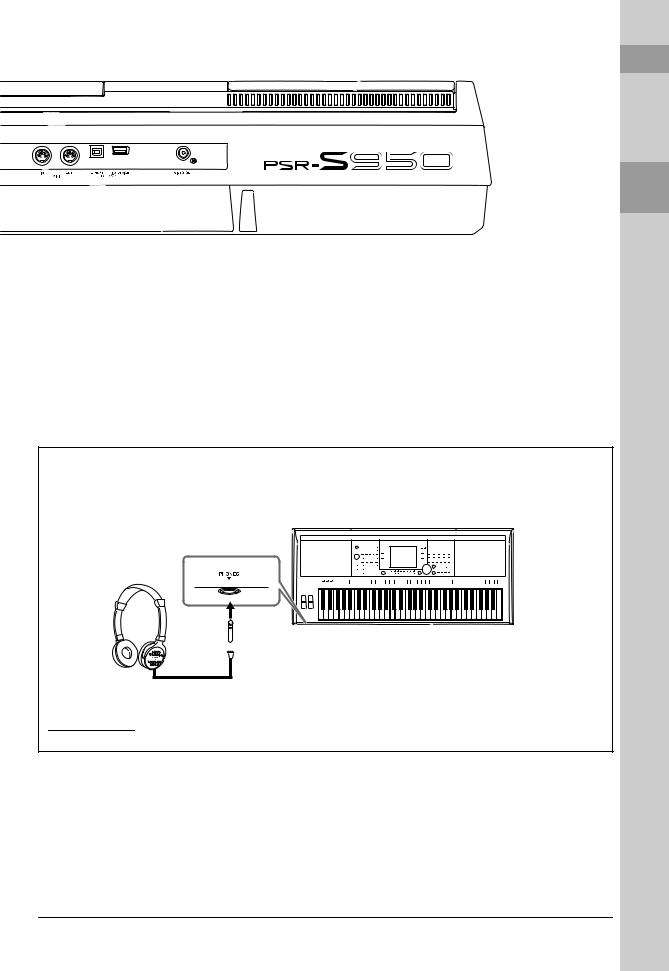
8 |
9 ) |
! |
7 |
[MIC LINE] switch (PSR-S950)....................... |
Page 88 |
) [USB TO DEVICE] terminal............................ |
Page 92 |
|
For switching between “MIC” and “LINE” for proper use of |
For connecting a USB flash memory. |
|
|
|
the [MIC/LINE IN] jack. |
|
! [VIDEO OUT] jack (PSR-S950) ...................... |
Page 90 |
8 MIDI [IN]/[OUT] terminals............................... |
Page 94 |
For connecting to a television or video monitor. |
|
|
|
For connecting external MIDI devices. |
|
|
|
9 |
[USB TO HOST] terminal................................ |
Page 93 |
|
|
|
For connecting to a computer. |
|
|
|
Using the Headphones
Connect a pair of headphones to the [PHONES] jack. The internal stereo speaker system is automatically shut off when a pair of headphones is plugged into the [PHONES] jack.
 Standard phone plug
Standard phone plug
 CAUTION
CAUTION
Do not listen with the headphones at high volume for long periods of time. Doing so may cause hearing loss.
Panel Controls and Terminals
PSR-S950/S750 Owner’s Manual |
13 |
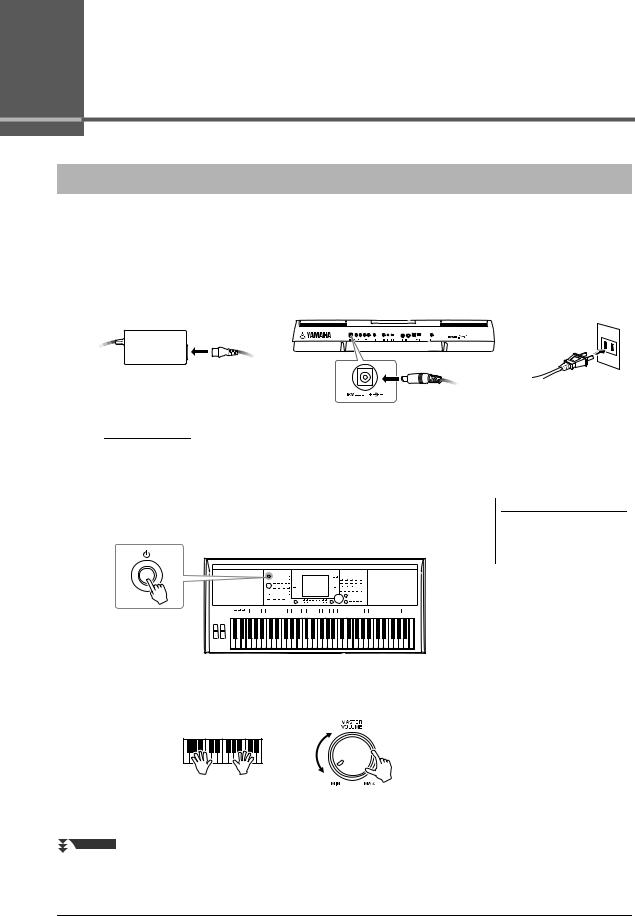
Starting Up
Turning the Power On and Playing the Keyboard
1Connect the power adaptor.
First connect one end of the AC cable to the power adaptor, then connect the power adaptor’s DC plug to the instrument’s DC IN jack on the rear panel. Finally, connect the other end (normal AC plug) to the electrical outlet.
1-1 |
|
|
1-2 |
|
1-3 |
|||||||
|
|
|
|
|
|
|
|
|
|
|
|
|
|
|
|
|
|
|
|
|
|
|
|
|
|
|
|
|
|
|
|
|
|
|
|
|
|
|
|
|
|
|
|
|
|
|
|
|
|
|
|
|
|
|
|
|
|
|
|
|
|
|
|
|
AC cable
Power adaptor
DC plug
 WARNING
WARNING
The shape of the plug and outlet differs depending on locale.
Use the specified adaptor (page 100) only. The use of an incompatible adaptor may cause irreparable damage to the PSR-S950/S750, and may even pose a serious shock hazard! ALWAYS UNPLUG THE AC POWER ADAPTOR FROM THE AC OUTLET WHEN THE PSR-S950/S750 IS NOT IN USE.
2Press the [  ] (Standby/On) switch to turn the power on.
] (Standby/On) switch to turn the power on.
The main display appears.
NOTE
Before the main display appears, turning the power off, operating the buttons and playing the keyboard cannot be done.
3While playing the keyboard, use the [MASTER VOLUME] dial to adjust the volume to an appropriate level.
NEXT PAGE
14 PSR-S950/S750 Owner’s Manual
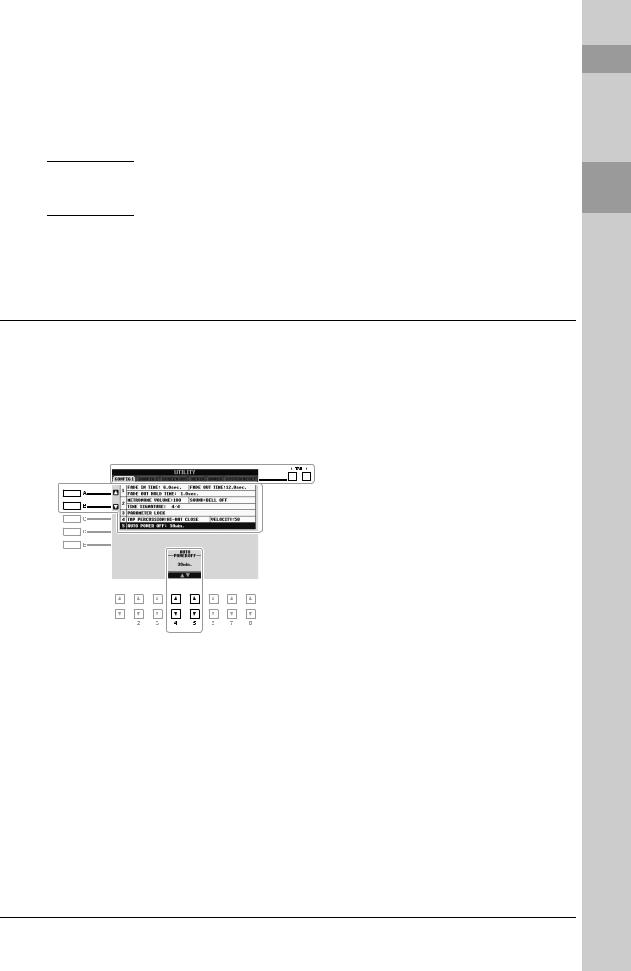
4After you use the instrument, press the [ ] (Standby/On) switch to turn the power off.
] (Standby/On) switch to turn the power off.
While recording or editing, or while messages are displayed:
The power cannot be turned off even if you press the [ ] (Standby/On) switch.
] (Standby/On) switch.
If you need to force-quit the instrument in such a situation, press and hold the [  ] (Standby/On) switch for longer than three seconds.
] (Standby/On) switch for longer than three seconds.
 CAUTION
CAUTION
Even when the instrument is turned off, electricity is still flowing to the instrument at a minimum level. When not using the instrument for an extended period of time, be sure to unplug the AC power adaptor from the wall AC outlet.
NOTICE
If you force-quit the instrument during recording or editing, the data might be lost, and the instrument and external devices might be damaged.
Setting the Auto Power Off function
To prevent unnecessary power consumption, this instrument features an Auto Power Off function that automatically turns the power off if the instrument is not operated for a specified period of time. The amount of time that elapses before the power is automatically turned off can be set as described below (default setting: 30 min.). The setting is retained even if the power is turned off.
1 Call up the operation display. |
|
|
NOTE |
||||
|
|||||||
[FUNCTION] [I] UTILITY TAB [E][F] CONFIG 1 |
|
|
Throughout this manual, arrows are |
||||
|
|
|
|
|
|
|
used in the instructions, indicating in |
|
|
|
|
|
|
|
shorthand the process of calling up |
|
|
|
|
|
|
|
certain displays and functions. |
2 |
|
|
|
|
|
|
NOTICE |
|
|
|
|
|
|
||
|
|
|
|
|
|
||
|
|
|
|
|
|
||
|
|
|
|
|
|
|
• Depending on the instrument |
|
|
|
|
|
|
|
|
|
|
|
|
|
|
|
status, the power may not turn |
|
|
|
|
|
|
|
off automatically, even after |
|
|
|
|
|
|
|
|
|
|
|
|
|
|
|
the elapse of the specified |
|
|
|
|
|
|
|
|
|
|
|
|
|
|
|
period of time. Always turn off |
|
|
|
|
|
|
|
the power manually when the |
|
|
|
|
|
|
|
instrument is not in use. |
|
|
|
|
|
|
|
• The data which is not saved to |
|
|
|
|
|
|
|
the USER or USB drive will be |
|
|
|
|
|
|
|
lost if the power automatically |
|
|
|
|
|
|
|
turns off. Make sure to save |
|
|
|
|
|
|
|
your data before the power |
3 |
|
|
|||||
|
|
turns off. |
|||||
|
|
|
|
|
|
|
|
2 Use the [A]/[B] buttons to select “5. AUTO POWER OFF.” |
|
||||||
3 Press the [4 ]/[5 ] buttons to set the value. |
|
|
NOTE |
||||
|
|||||||
If you do not want to turn the power off automatically (disable the Auto Power |
|
|
The setting time is approximate. |
||||
Off), select OFF. |
|
|
|
||||
Starting Up
PSR-S950/S750 Owner’s Manual |
15 |
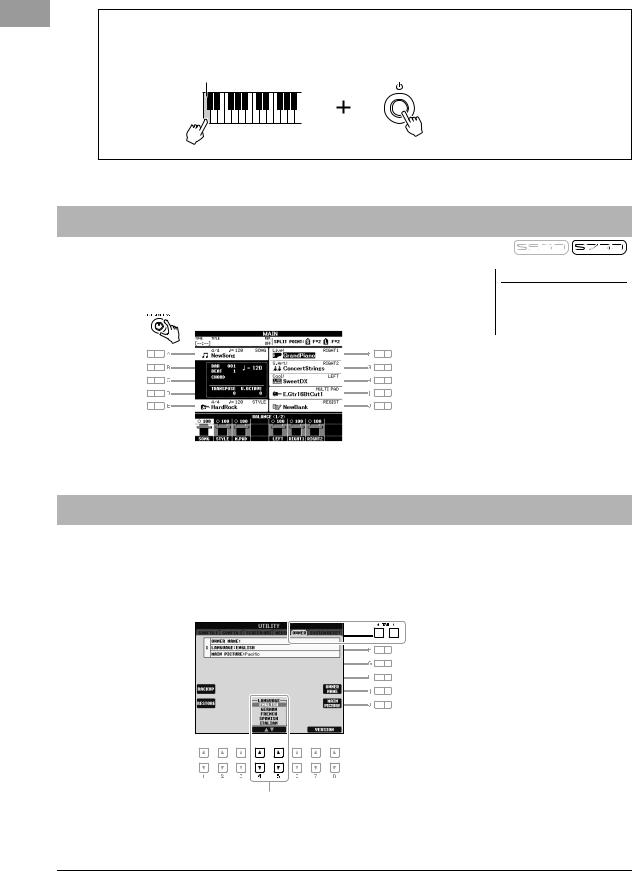
Disabling Auto Power Off (simple method)
Turn the power on while holding down the lowest key (C1) on the keyboard. An “Auto power off disabled” message appears briefly and Auto Power Off is disabled.
C1
Adjusting the Contrast of the Display (PSR-S750 only)
You can adjust the contrast of the display by turning the [LCD CONTRAST] knob located to the left of the display.
NOTE
Since the color display of the PSRS950 has a high level of visibility, no contrast adjustment function is necessary.
Changing the Display Language
This determines the language used in the display for messages.
1Call up the operation display.
[FUNCTION] [I] UTILITY TAB [E][F] OWNER
2
2Use the [4 ]/[5 ] buttons to select the desired language.
16 PSR-S950/S750 Owner’s Manual
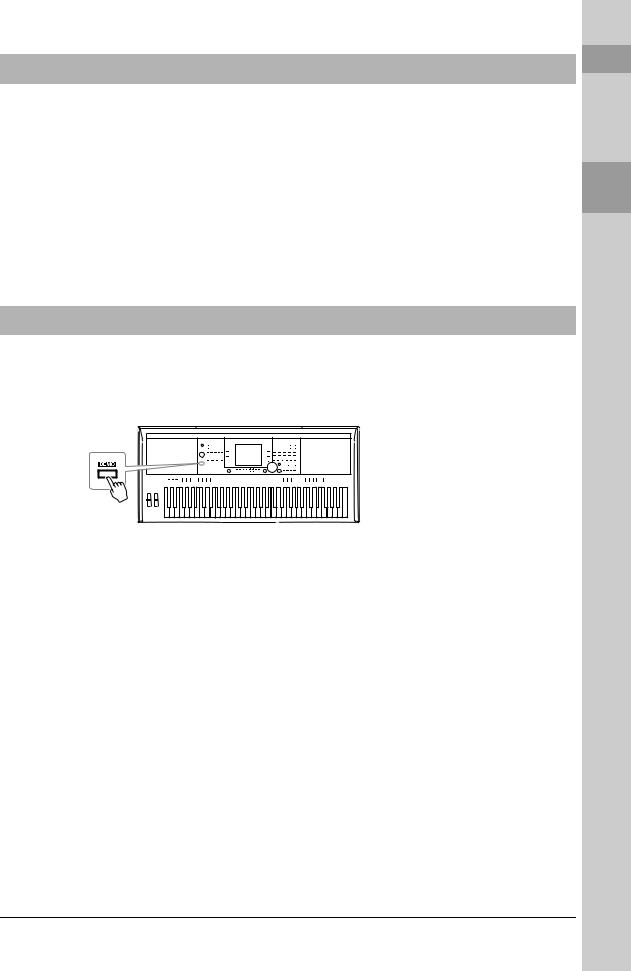
Displaying the Version Number
You can check the version number of this instrument.
1Call up the operation display.
[FUNCTION] [I] UTILITY TAB [E][F] OWNER
2Use the [7 ]/[8 ] (VERSION) buttons to display the version number.
3Press the [8 ] (EXIT) button (or the panel [EXIT] button) to return to the original display.
Playing the Demos
The Demos provide helpful, easy-to-understand introductions to the features and functions as well as sound demonstrations.
1Press the [DEMO] button to call up the Demo display.
2 |
|
|
|
|
|
|
|
|
|
|
|
|
|
|
|
|
|
Press one of the [A] – [E] and [J] buttons to show a specific |
|
|||||||
|
Demo. |
|
||||||
|
Pressing one of the [F] – [I] buttons plays back the overview Demo |
|
|
NOTE |
||||
|
|
|||||||
|
continuously, calling up the various displays in sequence. |
|
|
To return to the higher level menu, |
||||
|
|
|
|
|
|
|
|
press the [EXIT] button. |
|
The sub menus are shown at the bottom of the display. Press one of the [A] – [J] |
|
|
|
||||
|
|
|
||||||
|
buttons corresponding to the sub menu. |
|
||||||
3 |
Press the [EXIT] button several times to exit from the Demo |
|
||||||
|
display. |
|
||||||
PSR-S950/S750 Owner’s Manual |
17 |
Starting Up
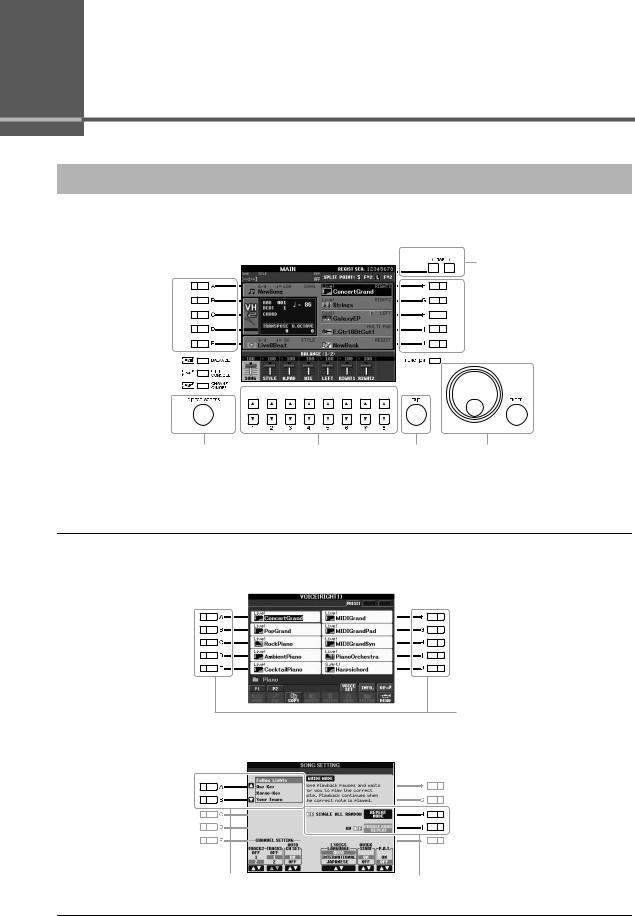
Basic Operations
Display-based Controls
The LCD provides comprehensive at-a-glance information on all current settings. The displayed menu can be selected or changed by the controls around the LCD.
TAB [E][F] buttons (page 19)
[A] – [E] buttons
(see below) 

 [F] – [J] buttons (see below)
[F] – [J] buttons (see below)
[DIRECT ACCESS] |
[1 ] – [8 ] buttons |
[EXIT] button |
[DATA ENTRY] dial and |
button (page 21) |
(page 19) |
(page 21) |
[ENTER] button |
|
|
|
(page 20) |
[A] – [J] buttons
The [A] – [J] buttons are used to select the corresponding menu.
• Example 1
In the File Selection display
(page 24), the [A] – [J] buttons can be used to select the corresponding respective files (Voices).
• Example 2
The [A] and [B] buttons are used to move the cursor up or down.
The [H] and [I] buttons are used to select the corresponding parameter.
18 PSR-S950/S750 Owner’s Manual
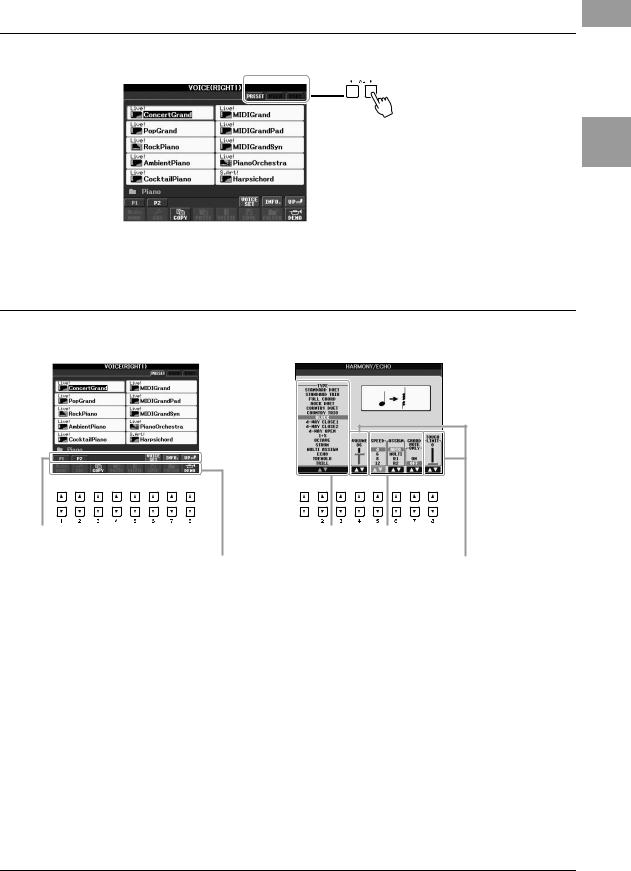
TAB [E][F] buttons
These buttons are used mainly to change the pages of displays that have “tabs” at the top.
Basic Operations
[1 ] – [8 ] buttons
The [1 ] – [8 ] buttons are used to make selections or adjust settings (up or down correspondingly) for functions shown directly above them.
For menus that appear in this section of the display, use the [1 ] – [8 ] buttons.
For menus that appear in this section of the display, use the [1 ] – [8 ] buttons.
For list menus that appear, use the [1 ]
– [8 ] buttons to select the desired item.
For parameters that appear in slider (or knob) form, use the [1 ] – [8 ] buttons to adjust the value.
PSR-S950/S750 Owner’s Manual |
19 |
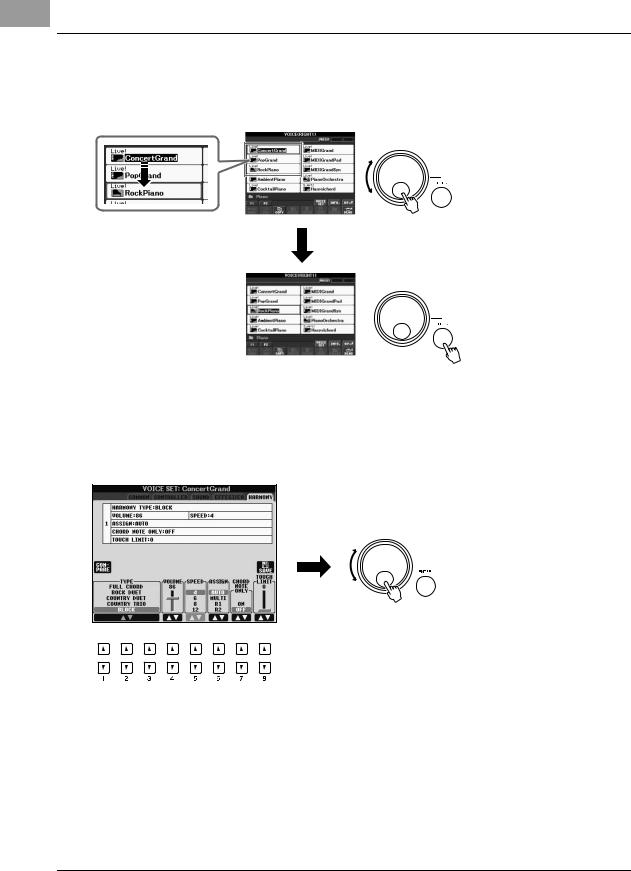
[DATA ENTRY] dial and [ENTER] button
Depending on the selected LCD, the [DATA ENTRY] dial can be used in the following two ways.
• Selecting files (including Voices, Styles and Songs)
When one of the File Selection displays (page 24) is shown, you can use the [DATA ENTRY] dial and the [ENTER] button to select a file (Voices, Styles, Songs, and others).
Rotate the [DATA ENTRY] dial to move the cursor.
Press the [ENTER] button to actually select the highlighted file.
• Adjusting the parameter values
You can conveniently use the [DATA ENTRY] dial in tandem with the [1 ] – [8 ] buttons to adjust parameters indicated in the display.
Rotate the [DATA ENTRY] dial to adjust the selected parameter.
Select the desired parameter with the appropriate [1 ] – [8 ] button.
This convenient technique also works well with pop-up parameters such as Tempo and Transpose. Simply press the appropriate button (ex., TEMPO [+]), then rotate the [DATA ENTRY] dial to set the value, then press [ENTER] to close the window.
20 PSR-S950/S750 Owner’s Manual
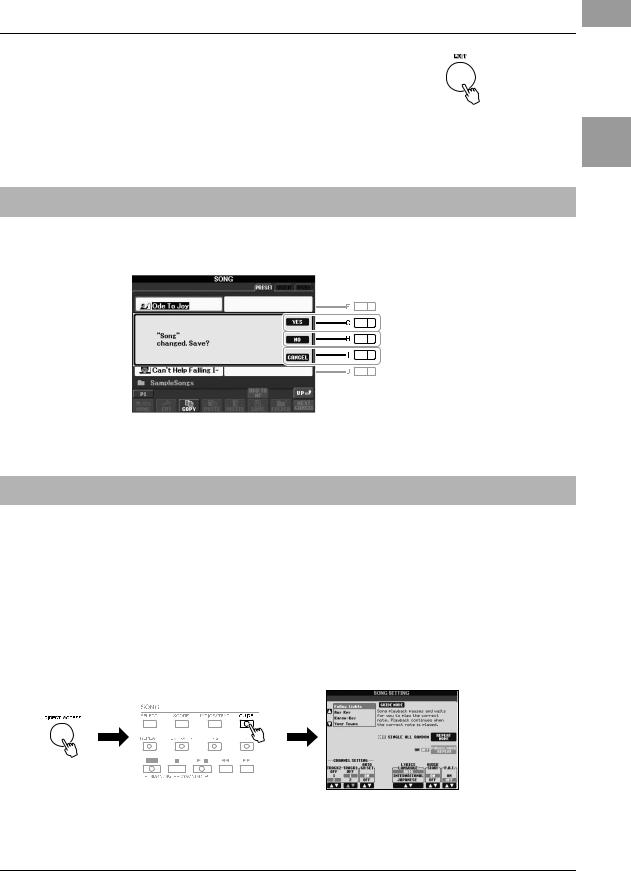
[EXIT] button
Pressing the [EXIT] button returns you to the previously indicated display. Pressing the [EXIT] button several times returns to the default Main display (page 22).
Messages Shown in the Display
A message (information or confirmation dialog) sometimes appears on the screen to facilitate operation. When the message appears, simply press the appropriate button.
Instant Selection of the Displays — Direct Access
With the convenient Direct Access function, you can instantly call up the desired display — with just a single additional button press.
1Press the [DIRECT ACCESS] button.
A message appears in the display prompting you to press the appropriate button.
2Press the button (or move the wheel or connected pedal) corresponding to the desired setting display to instantly call up that display.
For example, pressing the [GUIDE] button calls up the display in which the Guide mode can be set.
Refer to the Data List for a list of the displays that can be called up with the Direct Access function. The Data List is available at the Yamaha website. (See page 7.)
PSR-S950/S750 Owner’s Manual |
21 |
Basic Operations
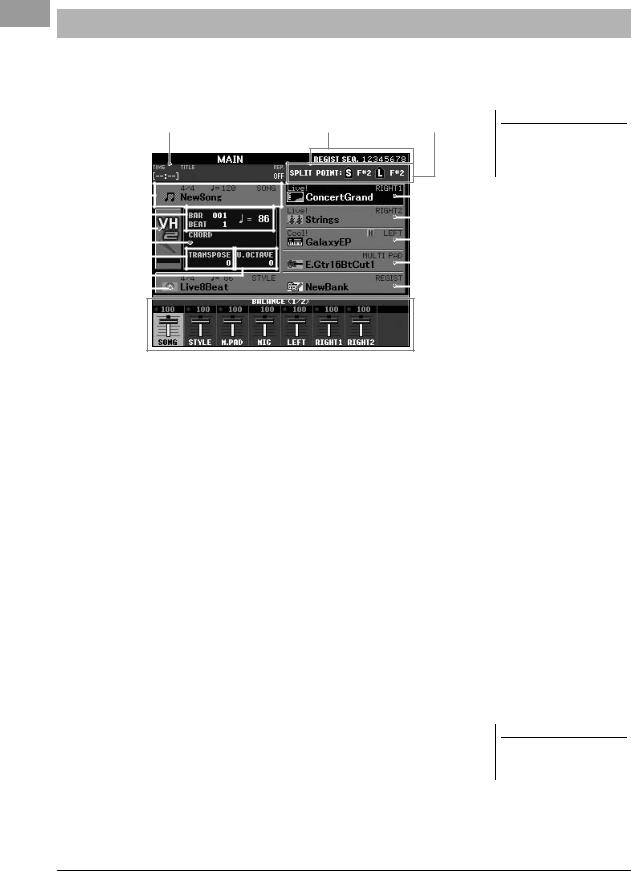
Main Display Configuration
The display that appears when the power is turned on is the Main display. The Main display shows the current basic settings such as the currently selected Voice and Style, allowing you to see them at a single glance. The Main display is the one you’ll usually see when you play the keyboard.
! |
@ |
# |
1 |
|
|
|
|
|
|
|
|
|
|
|
|
|
|
|
7y |
|
|
|
|
|
|
|
|
|
|
|
|
|
|
|||
2 |
|
|
|
|
|
|
|
|
|
|
|
|
|
|
|
|
|
|
|
|
|
|
|
|
|
|
|
|
|
|
|
|
|
|
|
|
|
|
|
|
|
|
|
|
|
|
|
|
||
|
|
|
||||||||||||||
$ |
|
|
|
|
|
|
|
|
|
|
|
|
|
|
|
|
|
|
|
|
|
|
|
|
|
|
|
|
|
|
|
||
3 |
|
|
|
|
|
|
|
|
|
|
|
|
|
|
|
|
|
|
|
||||||||||||||
|
|
|
|
|
|
|
|
|
|
|
|
|
|
|||
4 |
|
|
|
|
|
|
|
|
|
|
|
|
|
|
|
8u |
|
|
|
|
|
|
|
|
|
|
|
|
|
|
|
||
5 |
|
|
|
|
|
|
|
|
|
|
|
|
|
|
|
|
|
|
|
|
|
|
|
|
|
|
|
|
|
|
|
9u |
|
|
|
|
|
|
|
|
|
|
|
|
|
|
|
|
||
6 |
|
|
|
|
|
|
|
|
|
|
|
|
|
|
|
|
|
|
|||||||||||||||
|
|
|
|
|
|
|
|
|
|
|
|
|
|
NOTE
Here’s a convenient way to return to the Main display from any other display: Simply press the [DIRECT ACCESS] button, then the [EXIT] button.
 )
)
1Song name and related information
Displays the currently selected Song name, time signature and tempo. Pressing the [A] button calls up the Song Selection display (page 54).
2 Bar/Beat/Tempo
Displays the current position (bar/beat/tempo) in Style playback or Song playback.
3Current chord name
When the [ACMP] button is set to on, the chord specified in the chord section of the keyboard will be displayed. When the Song containing the chord data is played, the current chord name will be displayed.
4Transpose
Displays the amount of transposition in semitone units (page 38).
5Upper Octave
Displays the amount that the octave value is shifted (page 38).
6Style name and related information
Displays the currently selected Style name, time signature and tempo. Pressing the [E] button calls up the Style Selection display (page 43).
7Voice name
Displays the Voice names currently selected for RIGHT 1, RIGHT 2 and LEFT parts (page 35). Pressing one of the [F] – [H] buttons calls up the Voice Selection display for each part.
8Multi Pad Bank name
Displays the names of the selected Multi Pad Bank. Pressing the [I] button calls up the Multi Pad Bank Selection display (page 69).
NOTE
When the Left Hold function (page 35) is on, an “H” indication appears next to the part name.
22 PSR-S950/S750 Owner’s Manual

9Registration Memory Bank name
Displays the currently selected Registration Memory Bank name and Registration Memory number. Pressing the [J] button calls up the Registration Memory Bank Selection display (page 80).
)Volume Balance
Displays the volume balance among the parts in two pages. Adjust the volume balance among the parts by using the [1 ] – [8 ] buttons (page 53).
!USB Audio information
Displays information for the selected audio file (elapsed playback time, file name and repeat mode). When the recording of USB Audio is in standby, a “REC WAIT” indication appears. While recording, “REC” appears.
@Registration Sequence
Indicates the sequence order of the Registration Memory (page 79) numbers, which can be called up via the TAB [E][F] buttons or the pedal. For instructions on programming the sequence, refer to the Reference Manual on the website.
#Split Point
Displays the Split Point positions (page 35).
$MIC Input level indicator (PSR-S950)
When a microphone is connected, this indicates the input level. Adjust the level with the [INPUT VOLUME] knob so that the indicator lights in green or yellow (but not in red). For details on the [INPUT VOLUME], refer to page 83. Pressing the [B]/[C]/[D] buttons calls up the Vocal Harmony Type Selection display.
NOTE
If the Volume Balance display is not shown, press the [BALANCE] button to show the Volume Balance display.
Basic Operations
PSR-S950/S750 Owner’s Manual |
23 |

File Selection Display Configuration
The File Selection display is for selecting Voice, Styles, and other data. The File Selection display appears when you press one of the VOICE or STYLE category selection buttons, SONG [SELECT] button, etc.
|
|
|
|
|
|
REGIST BANK |
MULTI PAD CONTROL |
|
|
|
|
|
|
||||||||||||||||||||||
|
|
|
SONG |
[SELECT] buttons |
[SELECT] button |
|
|
|
|
|
|
||||||||||||||||||||||||
|
|
|
[SELECT] |
|
|
|
|
|
|
|
|
|
|
|
|
|
|
|
|
|
|
|
|
|
|
|
|
|
|
|
|
|
|
||
|
|
|
button |
|
|
|
|
|
|
|
|
|
|
|
|
|
|
|
|
|
|
|
|
|
|
|
|
|
|
|
|
|
|
||
|
|
|
|
|
|
|
|
|
|
|
|
|
|
|
|
|
|
|
|
|
|
|
|
|
|
|
|
|
|
|
|
|
|||
|
|
|
|
|
|
|
|
|
|
|
|
|
|
|
|
|
|
|
|
|
|
|
|
|
|
|
|
|
|
|
|
|
|
|
|
|
|
|
|
|
|
|
|
|
|
|
|
|
|
|
|
|
|
|
|
|
|
|
|
|
|
|
|
|
|
|
|
|
|
|
|
|
|
|
|
|
|
|
|
|
|
|
|
|
|
|
|
|
|
|
|
|
|
|
|
|
|
|
|
|
|
|
|
|
|
|
|
|
|
|
|
|
|
|
|
|
|
|
|
|
|
|
|
|
|
|
|
|
|
|
|
|
|
|
|
|
|
|
|
|
|
|
|
|
|
|
|
|
|
|
|
|
|
|
|
|
|
|
|
|
|
|
|
|
|
|
|
|
|
|
|
|
|
|
|
|
|
|
|
|
|
|
|
|
|
|
|
|
|
|
|
|
|
|
|
|
|
|
|
|
|
|
|
|
|
|
|
|
|
|
|
|
|
|
|
|
|
|
|
|
|
|
|
|
|
|
|
|
|
|
|
|
|
|
|
|
|
|
|
|
|
|
|
|
|
|
|
|
|
|
|
|
|
|
|
|
|
|
|
|
|
|
|
|
|
|
|
|
|
|
|
|
|
|
|
|
|
|
|
|
|
|
|
|
|
|
|
|
|
|
|
|
|
|
|
|
|
|
|
|
|
|
|
|
|
|
|
|
|
|
|
|
|
|
|
|
|
|
|
|
|
|
|
|
|
|
|
|
|
|
|
|
|
|
|
|
|
|
|
|
|
|
|
|
|
|
|
|
|
|
|
|
|
|
|
|
|
|
|
|
|
|
|
|
|
|
|
|
|
|
|
|
|
|
|
|
|
|
|
|
|
|
|
|
|
|
|
|
|
|
|
|
|
|
|
|
|
|
|
|
|
|
|
|
|
|
|
|
|
|
|
|
|
|
|
|
|
|
|
|
|
|
|
|
|
|
|
|
|
|
|
|
|
|
|
|
|
|
|
|
|
|
|
|
|
|
|
|
|
|
|
|
|
|
|
|
|
|
|
|
|
|
|
|
|
|
|
|
|
|
|
|
|
|
|
|
|
|
|
|
|
|
|
|
|
|
|
|
|
|
|
|
|
|
|
|
|
|
|
|
|
|
|
|
|
|
|
|
|
|
|
|
|
|
|
|
|
|
|
|
|
|
|
|
|
|
|
|
|
|
|
|
|
|
|
|
|
|
|
|
|
|
|
|
|
|
|
|
|
|
|
|
|
|
|
|
|
|
|
|
|
|
|
|
|
|
|
|
|
|
|
|
|
|
|
STYLE category |
|
VOICE category |
||
selection buttons |
|
selection buttons |
||
|
|
|
|
|
|
|
|
|
|
|
|
|
|
|
|
|
|
|
|
1 |
|
|
|
|||
|
|
|
|
|
y |
|
|
|
2 |
||
|
|
||||
|
|
|
|
|
y |
|
|
|
3 |
||
|
|
||||
|
|
|
|
|
y |
1 Location (drive) of data |
|||||
PRESET |
Location where pre-programmed (preset) data is stored. |
||||
USER |
Location where recorded or edited data is saved. Installed |
||||
|
Expansion Voices or Styles are also saved here in the Expan- |
||||
|
sion folder. |
||||
USB |
Location where data on USB flash memory is saved. This |
||||
|
appears only when USB flash memory is connected to the |
||||
|
[USB TO DEVICE] terminal (page 92). |
||||
NOTE
By pressing the [USB] button, you can also access the files of Voice, Styles, and other data which are saved in the USB flash memory.
[USB] [A] SONG/[B] AUDIO/[C] STYLE/[F] VOICE(RIGHT1)/[G] MULTI PAD/[H] REGIST.
24 PSR-S950/S750 Owner’s Manual
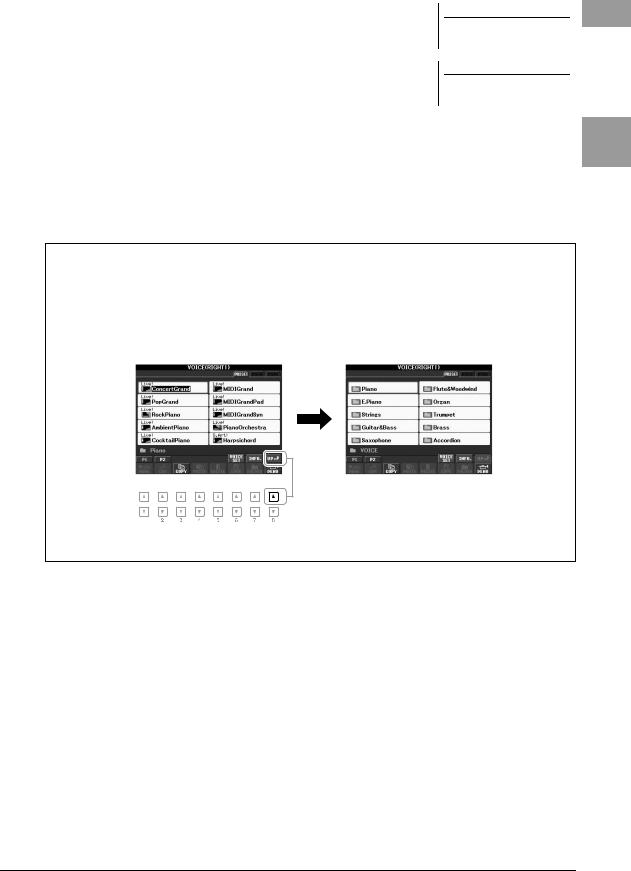
2Selectable data (files)
The files that can be selected on this display are shown. If more than 10 files exist, the page numbers (P1, P2 ...) are shown below the files. Pressing the corresponding button changes the display page. When other pages follow, the “Next” button appears, and for the previous page, the “Prev.” button appears.
3File/folder operation menu
You can save and manage your data files (copy, move, delete, etc.) from this menu. For detailed instructions, refer to pages 26 – 29.
NOTE
The data, both pre-programmed and your own original, are saved as “files.”
NOTE
The number of pages shown varies depending on the Selection display.
Closing the current folder and calling up the next highest level folder
In the PRESET display, several data (files) are contained together in a folder. You can also organize your original data in the USER/USB display by creating several new folders (page 27).
To close the current folder and call up the next highest level folder, press the [8 ] (UP) button.
Example: PRESET Voice Selection display
The PRESET Voice files are categorized and contained in appropriate folders.
The next highest level — in this case, folder — is shown. Each folder shown in this display contains appropriately categorized Voices.
This display shows the Voice files in a folder.
Basic Operations
PSR-S950/S750 Owner’s Manual |
25 |
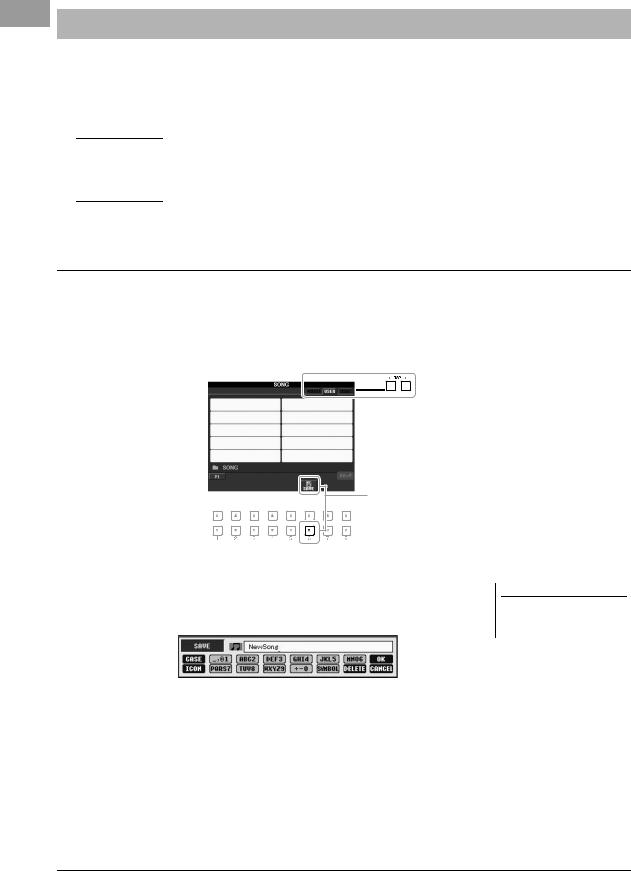
File Management
You can save your original data (such as Songs you’ve recorded and Voices you’ve edited) as a file to internal memory (User drive) or a USB flash memory. If you’ve saved a lot of files, it may be difficult to find the desired file quickly. To make it easier to find the files you want, you can organize your files in folders, rename the files, delete unnecessary files, etc. These operations are done in the File Selection display.
IMPORTANT
•Saving files or creating new folders cannot be done in the PRESET tab or the Expansion folder (installed Expansion Pack) in the USER tab.
•Files in the PRESET tab and the Expansion folder in the USER tab cannot be renamed/moved/deleted.
•Files in the Expansion folder in the USER tab cannot be copied.
NOTE
Before using a USB flash memory, be sure to read “Connecting a USB Flash Memory” on page 92.
Saving a File
This operation lets you save your original data (such as Songs you’ve recorded and Voices you’ve edited) as a file.
1In the File Selection display, select the appropriate tab (USER or USB) to which you want to save the data by using the TAB [E][F] buttons.
2
2Press the [6 ] (SAVE) button.
The naming display is called up.
3Enter the file name (page 30).
Even if you skip this step, you can rename the file at any time after saving it (page 28).
NOTE
If you want to cancel the Save operation, press the [8 ] (CANCEL) button.
4Press the [8 ] (OK) button to save the file.
The saved file will be automatically located at the appropriate position among the files in alphabetical order.
26 PSR-S950/S750 Owner’s Manual
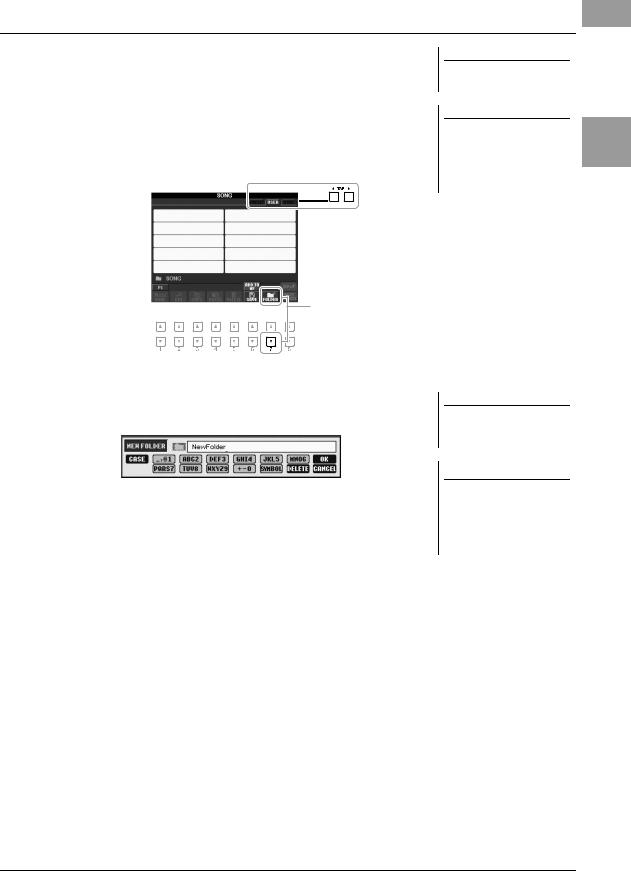
Creating a New Folder
This operation lets you create new folders. Folders can be created, named and organized as desired, making it easier to find and select your original data.
1In the File Selection display, select the appropriate tab (USER or USB) to which you want to create a new folder by using the TAB [E][F] buttons.
If you want to create a new folder within an existing folder, select the folder here first.
NOTE
The maximum number of files/folders which can be saved in a folder is 500.
NOTE
In the USER tab display, folder directories can contain up to four levels. The maximum total number of files/folders which can be saved differs depending on the file size and the length of the file/folder names.
2
2
3
Press the [7 ] (FOLDER) button.
The naming display for a new folder is called up.
Input the name of the new folder (see page 30).
NOTE
If you want to cancel to create a new folder, press the [8 ] (CANCEL) button.
NOTICE
Name the folder to something other than “Expansion.” Otherwise, all data contained in the “Expansion” folder will be lost when an Expansion Pack is installed.
Basic Operations
PSR-S950/S750 Owner’s Manual |
27 |
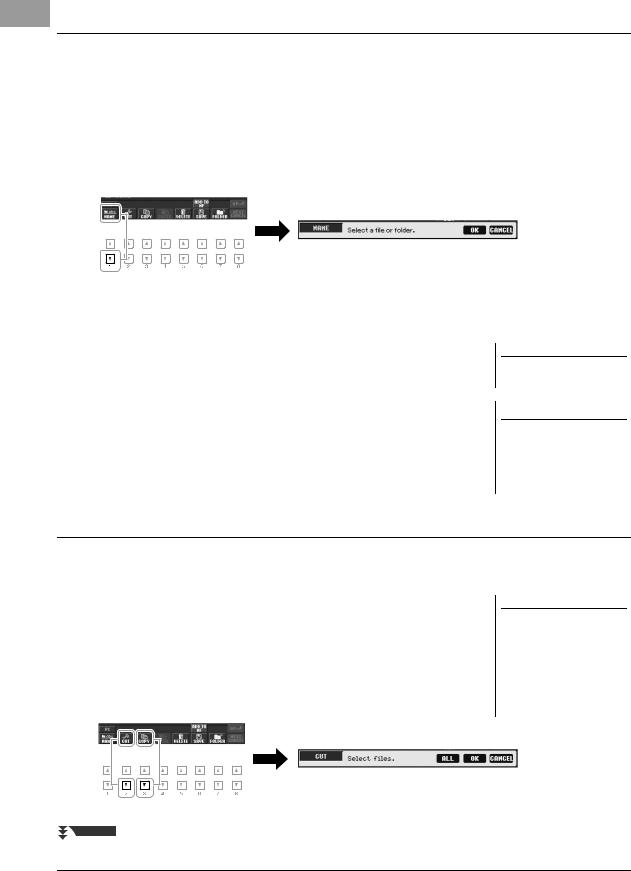
Renaming a File/Folder
This operation lets you rename files/folders.
1In the File Selection display, select the appropriate tab (USER or USB) which contains the file/folder you want to rename by using the TAB [E][F] buttons.
2Press the [1 ] (NAME) button.
The pop-up window for the Rename operation appears at the bottom of the display.
3Press one of the [A] – [J] buttons corresponding to the desired file/folder.
4Press the [7 ] (OK) button to confirm the file/folder selection.
The naming display is called up.
5Input the name (characters) of the selected file or folder (page 30).
The renamed file/folder appears on the display at the appropriate position among the files in alphabetical order.
NOTE
To cancel the Rename operation, press the [8 ] (CANCEL) button.
NOTICE
Name the folder to something other than “Expansion.” Otherwise, all files contained in the “Expansion” folder will be lost when an Expansion Pack is installed.
Copying or Moving Files
This operation lets you copy or cut a file (or files) and paste it/them to another location (folder). You can also copy folders (but not move them) by using the same procedure.
1In the File Selection display, select the appropriate tab (USER or USB) which contains the file/folder you want to copy by using the TAB [E][F] buttons.
2Press the [3 ] (COPY) button to copy or [2 ] (CUT) to move.
The pop-up window for the Copy/Cut operation appears at the bottom of the display.
NOTE
•Protected Songs which are saved to the User drive are marked by a “Prot. 1” indication at the upper left side of the file names and cannot be copied/moved to USB flash memories.
•Commercially available song data may be copy protected to prevent illegal copying.
NEXT PAGE
28 PSR-S950/S750 Owner’s Manual
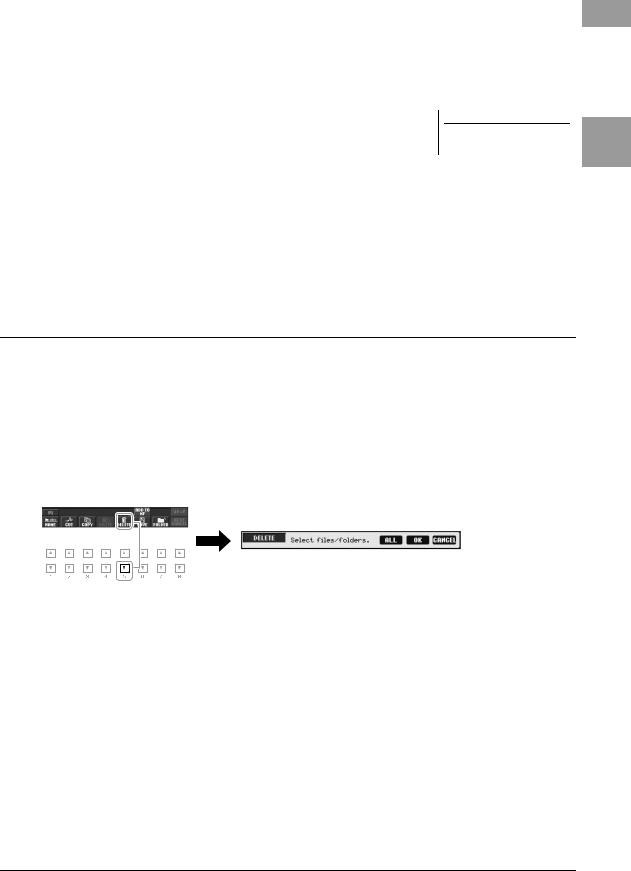
3Press one of the [A] – [J] buttons corresponding to the desired file/folder.
To cancel the selection, press the same [A] – [J] button again.
Press the [6 ] (ALL) button to select all files/folders indicated on the current display including the other pages. To cancel the selection, press the [6 ] (ALL
OFF) button again.
4Press the [7 ] (OK) button to confirm the file/folder selection.
5Select the destination tab (USER or USB) to paste the file/folder, by using the TAB [E][F] buttons.
If necessary, select the destination folder by using the [A] – [J] buttons.
6Press the [4 ] (PASTE) button to paste the file/folder selected in step 3.
The pasted file/folder appears on the display at the appropriate position among the files in alphabetical order.
NOTE
To cancel the Copy operation, press the [8 ] (CANCEL) button.
Deleting Files/Folders
This operation lets you delete individual or multiple files/folders.
1In the File Selection display, select the appropriate tab (USER or USB) which contains the file/folder you want to delete by using the TAB [E][F] buttons.
2Press the [5 ] (DELETE) button.
The pop-up window for the Delete operation appears at the bottom of the display.
3Press one of the [A] – [J] buttons corresponding to the desired file/folder.
To cancel the selection, press the same [A] – [J] button again.
Press the [6 ] (ALL) button to select all files/folders indicated on the current display including the other pages. To cancel the selection, press the [6 ] (ALL
OFF) button again.
4 |
|
|
|
NOTE |
Press the [7 ] (OK) button to confirm the file/folder selection. |
|
To cancel the Delete operation, press |
||
|
|
|
|
the [8 ] (CANCEL) button. |
5 |
|
|
|
|
Follow the on-display instructions. |
|
|||
|
• YES |
Delete the file/folder |
|
|
|
• YES ALL |
Delete all selected files/folders |
|
|
|
• NO |
Leave the file/folder as is without deleting |
|
|
|
• CANCEL |
Cancel the Delete operation |
|
|
Basic Operations
PSR-S950/S750 Owner’s Manual |
29 |
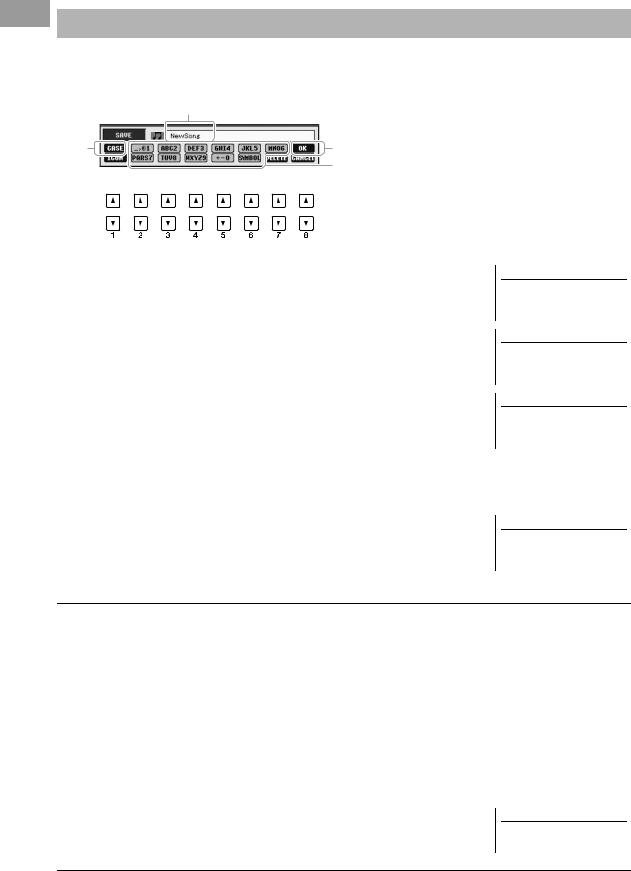
Entering Characters
The instructions that follow show you how to enter characters for naming your files/folders, inputting keywords to search for the appropriate panel settings (Music Finder), etc. Entering characters should be done in the display shown below.
|
2 |
1 |
4 |
|
3 |
Several different characters are assigned to each button, and the characters change each time you press the button.
1Change the type of character by pressing the [1 ] button.
• CASE |
Capital letters, numbers, marks |
• case |
Lowercase letters, numbers, marks |
2Use the [DATA ENTRY] dial to move the cursor to the desired position.
NOTE
When inputting lyrics in the Song Creator function, you may also enter Japanese characters (kana and kanji).
NOTE
The following marks cannot be entered for a file/folder name.
\ / : * ? " < > |
3Press the [2 ] – [6 ] and [7 ] buttons, corresponding to the character you wish to enter.
To actually enter the selected character, move the cursor or press another letterinput button. Alternately, you can wait for a short time and the character will be entered automatically.
For details on entering characters, refer to “Other character-entry operations” below.
NOTE
The file name can contain up to 41 characters and the folder name can contain up to 50 characters.
4Press the [8 ] (OK) button to actually enter the new name and return to the previous display.
NOTE
To cancel the character-entering operation, press the [8 ] (CANCEL) button.
Other character-entry operations
• Deleting characters
Move the cursor to the character you wish to delete by using the [DATA ENTRY] dial, and press the [7 ] (DELETE) button. To delete all characters on the line at once, press and hold the [7 ] (DELETE) button.
•Entering marks or space
1.Press the [6 ] (SYMBOL) button to call up the mark list.
2.Use the [DATA ENTRY] dial to move the cursor to the desired mark or space, then press the [8 ] (OK) button.
•Selecting custom icons for files (shown at left of file name)
1.Press the [1 ] (ICON) button to call up the ICON SELECT display.
2.Select the icon by using the [A] – [J] buttons, [3 ] – [5 ] buttons or [DATA ENTRY] dial. The ICON display includes several pages. Press the TAB [E][F] buttons to select different pages.
3.Press the [8 ] (OK) button to apply the selected icon.
NOTE
To cancel the operation, press the [8 ] (CANCEL) button.
30 PSR-S950/S750 Owner’s Manual
